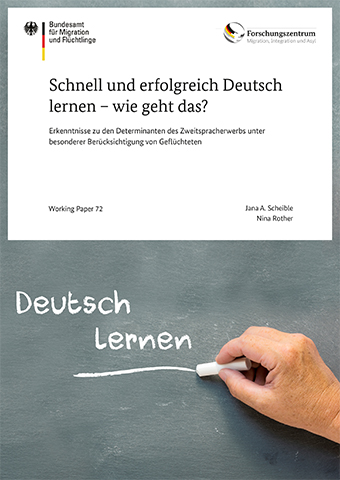How to: Learn German quickly and successfully ,

The study (Working Paper 72) serves to round off the research project entitled "Explaining differences in second language acquisition", and presents relevant factors influencing second language acquisition, which are put to the test in empirical terms in a secondary data analysis carried out by the BAMF's integration panel.
Individual learning conditions have a major influence on the acquisition of German
In particular a higher level of education, experience of learning a language in the past, having a first language which is linguistically closer to German, better knowledge of the first language, as well as a lower age, exert a positive influence on the acquisition of German during the integration course. A stronger interest in German language and culture, as well as enjoying the course, further encourage success in learning German. Course attendees who speak German more frequently in the course, as well as outside the course for instance at home, with friends or in their neighbourhoods, make particularly rapid progress when it comes to learning German.
Course attendees particularly benefit from having instructors who have a migration background and course leaders of the same gender
Contact

Course attendees whose instructors have a migration background but came from a different country of origin than the attendees learn particularly successfully. This is due to a more pronounced role model function, and can also stem from any experience that the instructors themselves may have of learning German. Female course attendees with female instructors find that their German improves particularly quickly.
The composition of the course is less important, but external differentiation and small groups are helpful
External differentiation and smaller groups reduce the strain on instructors and help them to tackle the individual needs among heterogeneous groups of learners in a targeted manner. Comparable growth in knowledge of German in courses which are homogeneous and heterogeneous in terms of the first language is contingent on the course attendees largely speaking German during the course and not switching to another lingua franca. This risk arises more in homogeneous groups.
The importance of taking displaced persons’ more difficult circumstances into account
The study confirms the effectiveness of the integration course as a tool for learning German, both for attendees with a displacement background and for those without. Displaced persons and immigrants with different motives for migration are comparable with regard to the rate at which their knowledge of German improves during the course. This indicates that the instructors are managing to accommodate the particular needs of attendees with a displacement background. Learning German quickly and successfully absolutely depends on course leaders taking account of displaced persons’ more difficult circumstances, including with regard to the asylum procedure, being housed in collective accommodation facilities, trauma relief, as well as health problems, and are adjusting the lesson framework accordingly.
The study is only available in German.
The study was drawn up by: Jana Anne Scheible and Dr. Nina Rother

